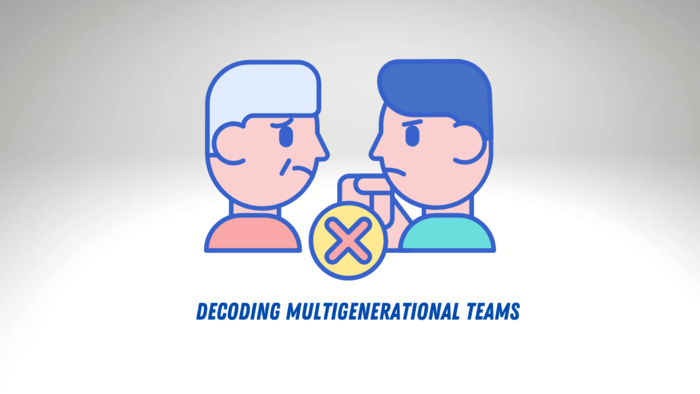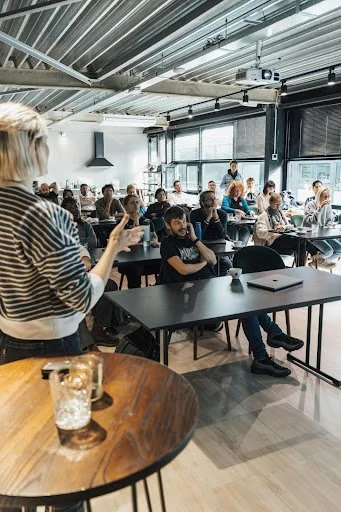Cultural Diversity: A Conduit for Knowledge Transfer
By Marion Davis
A new term has risen to prominence in the world of diversity, equity, and inclusion (DEI), and that term is cultural diversity. Cultural diversity challenges how people define diversity and how people include diversity.
Valiant efforts in current times have increased the employment of women and minority professionals according to the Bureau of Labor Statistics. At the same time, a 2022 article by Forbes noted a statistic that 70 percent of white men report feeling left out of DEI efforts and therefore disengage.
DEI practitioners must consider that Baby Boomers were born into an era where there was a significant white majority in the US–72 percent of this generation group is white versus only 56 percent of Millennials. With this racial demographic and a generational culture that emphasized men as the breadwinners in the household, understandably, senior-level Baby Boomer employees are predominantly white.
As white men report feeling disengaged by DEI efforts in organizations and more Baby Boomers are pushed into retirement by ageism and inaccessible workplaces, these factors are likely large contributors to the lack of knowledge transfer happening in the 2020s. One study found that the average enterprise-sized company in the US can lose $4.5 million annually in productivity by failing to preserve and pass along information. This loss is not experienced only within organizations but by individuals as well as Baby Boomers retire without being included in mentorship opportunities to pass along knowledge to younger professionals of all backgrounds to give these professionals a competitive edge.
The term cultural diversity makes space for the inclusion of white men who do not identify as a member of a marginalized group and celebrates the differences present among all employees and what unique contributions they bring to the organization. While there is a time and a place for a more narrow lens that evaluates the needs of a specific marginalized group in the quest for equity, there is also a time and a place for a more holistic view of how all individuals’ unique attributes can be celebrated and included within the organizational ecosystem in a way that supports other members of the organization.
More specifically, cultural diversity in the workplace is gaining recognition as a tool for addressing the knowledge transfer gap in the US.
Defining Cultural Diversity
Also referred to as multiculturalism, cultural diversity focuses on bringing together people from many different walks of life and many different stages in life and celebrating these “socio-cultural differences.” Factors that constitute cultural diversity can include race, ethnicity, gender, sexual orientation, religious or spiritual beliefs, language, age, disability, and socioeconomic status.
Many discussions on diversity often heavily emphasize racial and gender disparities in the workplace–and rightfully so. However, to overlook appreciation for all humans in their unique differences and contributions does a disservice to our communities and can potentially widen gender- and race-based gaps further in the workplace.
An excellent example is that of Baby Boomers leaving the workforce without knowledge transfer occurring.
Taking a More Nuanced Look at Workplace Demographics
A recent look at Fortune 500 CEOs shows that Baby Boomers are being pushed into retirement as Gen X takes the majority in generational representation. However, Baby Boomers still make up a close second with 226 Baby Boomer Fortune 500 CEOs. This cohort is more likely to be white, male, and billionaires as compared to younger generations. Fortune determined this billionaire likelihood based on the fact that the median age for high net-worth individuals tended to be 69, and the online magazine posited that this fact was due to more time spent accumulating wealth and fewer financial obstacles during their younger years such as student debt payments and salaries that fail to keep up with inflation rates that have younger generations in a chokehold.
Removing obstacles to gender and racial diversity is an important organizational goal. At the same time, while using quantitative assessments to track diversity numbers, companies should consider certain factors such as age and generational trends. There are 76 million Baby Boomers in the US, and 72 percent of this generation group is white. In comparison, with population growth changes, Millennials in the US constitute an even larger group at 87 million but only 56 percent are white and only 52 percent of Gen Z are white. Additionally, Baby Boomers were born into a generational culture that outlined traditional roles as men being the breadwinner in the family.
Thus, by the very nature of generational culture and demographics, senior-level Baby Boomers in the workplace are likely to be white men. As Baby Boomers are pushed into retirement and the focus shifts to gender and racial diversity in the workplace made up primarily by members of the younger generations, companies are silently losing the wealth of information present in Baby Boomer executives’ organizational knowledge.
Including Inclusion of White Baby Boomers in Cultural Diversity to Encourage Knowledge Transfer Across Diversity Gaps
Organizations can take on a cultural diversity lens and recognize that every individual brings a unique perspective to the table. By taking a step back, reexamining how to include Baby Boomers, and celebrating cultural diversity in the workplace across all factors, organizations can leverage cultural diversity as a tool to facilitate knowledge transfer in the workplace in an approach that benefits employees of all backgrounds.
Rethinking Inclusion of White Baby Boomers
Within diversity, equity, and inclusion (DEI) discussions, many individuals typically picture an idea of inclusion to opportunities previously not available to historically oppressed groups. With this definition of inclusion in mind, DEI practitioners would likely bypass white Baby Boomers and see no need to make changes for this group. However, it is time to rethink inclusion.
Inclusion means to be included. Baby Boomers are notably one of the most philanthropic generations due to their generational culture highlighting the responsibility to give back to society. This same tendency is evident in Baby Boomers appreciating previous generations’ mentorship in the workplace and their sense of duty to pass on this mentorship. Furthermore, Baby Boomers report the greatest sense of belonging in the workplace when they feel trusted and respected in the workplace and white respondents specifically reported feeling belongingness more than other racial groups when their unique contributions were valued.
Thus, in DEI efforts, organizations should be asking if Baby Boomers–especially white Baby Boomers–are being included in an optimized manner. In this case, inclusion could refer partially to being provided access to opportunities to give back within the organization and to have their contributions valued. Additionally, DEI practitioners must consider disability as a prominent factor in including Baby Boomers. Work arrangements designed to address the rising level of disability among Baby Boomers should also recognize that there is a trend of Baby Boomers not wanting to identify as disabled and therefore seek accommodations. Organizations can take this fact into mind and strive to offer more flexible work arrangements without employees needing to ask for accommodations. This proactive approach will benefit all generations as 20 percent of people in the US under the age of 65 have a disability while 24 percent of people in the US aged 65 to 74 have a disability.
Successful inclusion of Baby Boomers in an organization can benefit all groups of people. Considering demographic differences across generations, the value of mentorship programs for all groups, and the immense need for more knowledge transfer to take place within organizations, a unique proposition here is for DEI practitioners to evaluate not only diversity and inclusion within the organization but to create mentorship programs and evaluate diversity and inclusion within these programs and their systemic effect within the organization.
How many senior-level Baby Boomers are enrolling in these programs? How are these Baby Boomers’ contributions being celebrated? What level of belongingness do these Baby Boomers report as a result? How many younger employees are enrolling and from what backgrounds? How are these younger employees benefitting from the mentorship program–especially across gender, race, and ethnicity where the majority of the Baby Boomer mentors are likely white men? How can these mentorship programs be optimized especially in regards to cross-culture mentorship?
The Impact of Mentorship Programs on All Employees
Through a celebration of cultural diversity, senior-level Baby Boomers’ generational culture can be appreciated for its unique aspects, such as the Baby Boomer tendency to value senior-junior mentoring as a tool for career advancement. Measures can be taken to assess Baby Boomers’ levels of reported belongingness in the workplace when they are given cross-generational mentorship opportunities and on the impact of these mentorship programs on diverse groups of mentees.
In addition to evaluations across the workplace of diversity numbers, organizations could more specifically evaluate diversity numbers in enrollment in mentorship programs. These programs typically result in retention rates for mentored employees that are 50 percent higher than employees not receiving mentorship.
Mentorship has especially been noted as a tool for promoting gender and racial equity. In a survey on the impact of senior-junior mentorship for women, Black women experienced the largest average salary increase correlating with mentorship at a 37.4 percent increase followed by Hispanic women at 26.3 percent. White women experienced a 12.8 percent increase, and Asian women experienced a 6.1 percent increase. Over half of women with mentors reported a high level of job satisfaction while less than 25 percent of women with mentors reported this same level of job satisfaction. Across races, 15 percent of women reported never having a mentor but only three percent of white women had never had a mentor.
The most common reason why women reported a lack of mentorship participation was not knowing how to find a mentor; the second most common reason was thinking that they did not need a mentor; and the third most common reason was that these women did not look up to anyone professionally within the organization. In a review of racial preferences among the women for mentors, white women at 62 percent and Black women at nearly 48 percent were most likely to have same-race preferences for mentorship. The least likely were Asian women at slightly more than 29 percent and Hispanic women at approximately 31 percent.
Implementing Practical Steps for Celebrating Cultural Diversity in the Workplace
Organizations can take steps to show appreciation for employees of all backgrounds. By celebrating differences across cultures, companies can create an internal ecosystem where all employees feel a sense of belonging and are included in a mutually beneficial manner. The following sections include practical steps that employers can take to celebrate cultural diversity in the workplace.
Establish Mentorship Programs
To bridge generational, racial, and gender gaps in the workplace, organizations can establish mentorship programs that connect individuals from diverse backgrounds. These programs can facilitate knowledge transfer and create opportunities for cross-generational and cross-cultural mentorship, benefiting both mentors and mentees.
Create Flexible Work Arrangements
Organizations should recognize and accommodate different needs and abilities by offering flexible work arrangements. This proactive approach helps create a workplace that supports employees from various age groups, including those with disabilities, without requiring them to request accommodations.
Add Cultural Celebrations
Organizations can recognize and celebrate cultural holidays, traditions, and observances. These celebrations can be integrated into the workplace culture and serve as opportunities for employees to share their cultural heritage with their colleagues. To celebrate Baby Boomers, companies can consider creating special occasions and holidays that honor this generation's contributions and experiences. Additionally, intergenerational activities, cultural festivals, and opportunities for storytelling and mentorship can promote cross-generational understanding and appreciation. Involving Baby Boomers in the planning ensures that these celebrations are meaningful and reflective of their interests and values.
Utilize Employee Resource Groups (ERGs)
Organizations can establish Employee Resource Groups (ERGs) that support various cultural identities. These groups provide a platform for employees to connect, share experiences, and advocate for cultural diversity in the workplace. To support Baby Boomers, organizations can establish a dedicated Employee Resource Group (ERG) specifically tailored to their needs. This Baby Boomer ERG can focus on mentorship and knowledge transfer, retirement planning assistance, health and wellness initiatives, workplace accessibility challenges, advocacy for age-inclusive policies, and cultural celebrations. It provides a platform for Baby Boomers to share their experiences and expertise while promoting intergenerational collaboration and understanding within the organization.
Final Thoughts
In sum, cultural diversity in the workplace serves as a powerful tool for addressing knowledge transfer gaps within organizations. By embracing and celebrating a variety of backgrounds, including factors like age, race, and gender, organizations can incorporate the unique perspectives of every individual. This article has emphasized the importance of including Baby Boomers in cultural diversity campaigns and recognizing their contributions and experiences. Inclusion means valuing all members of the workforce, regardless of generational or demographic differences. By implementing mentorship programs, flexible work arrangements, cultural celebrations, and utilizing Employee Resource Groups (ERGs), companies can create an inclusive ecosystem that creates understanding and encourages knowledge sharing, which ultimately benefits employees of all backgrounds.
Marion Davis is a contributing writer at EmployDiversityNetwork.com. She is a disabled DEIA consultant and writes on the value of diversity and inclusion across multiple industries, specifically as relates to disability and intersectionality.














